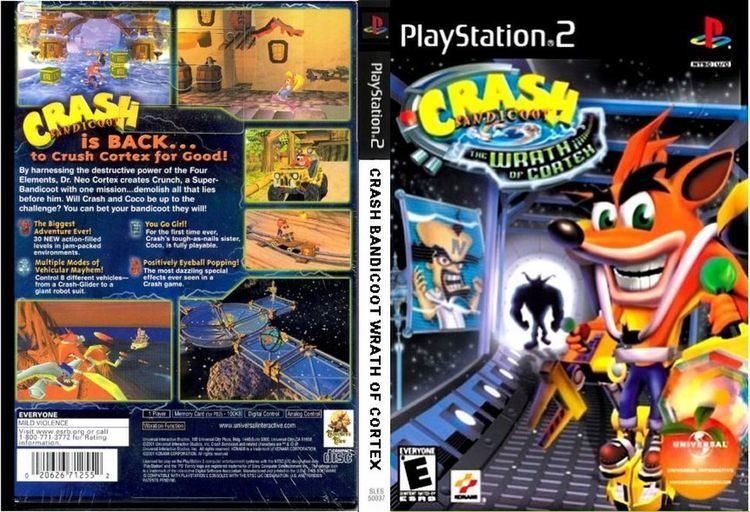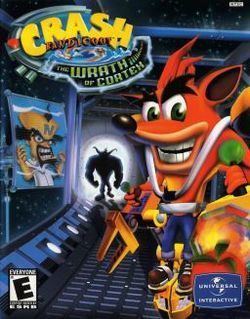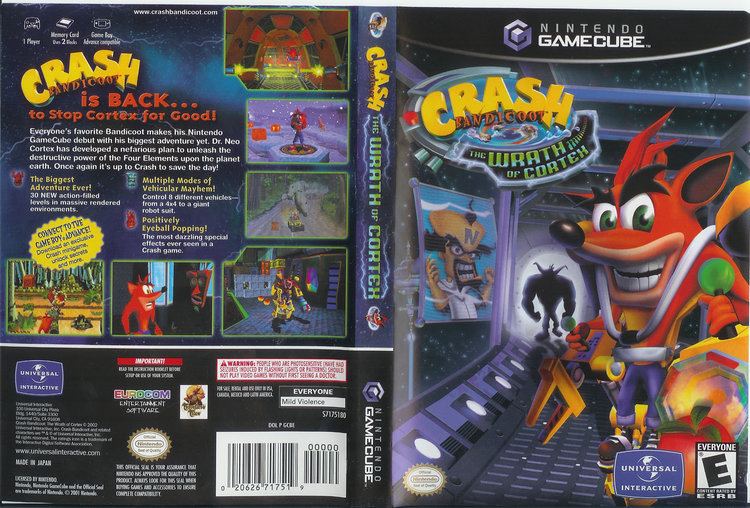7.8 /10 1 Votes7.8
7.4/10 IGN Programmer(s) John Hodskinson Initial release date 29 October 2001 Genre Platform game | 4.6/5 Emuparadise 66% GameFAQs Producer(s) Daniel Suarez Artist(s) James Cunliffe | |||||||||||||||||||||||||||||||||
 | ||||||||||||||||||||||||||||||||||
Distributor(s) Vivendi Universal Games Designer(s) Arthur ParsonsJon BurtonJames Cunliffe Similar Crash Bandicoot games, Vivendi games, Platform games | ||||||||||||||||||||||||||||||||||
Crash bandicoot the wrath of cortex full playthrough
Crash Bandicoot: The Wrath of Cortex is a platform game published by Universal Interactive Studios along with Konami and developed by Traveller's Tales for the PlayStation 2, Xbox and was ported by Eurocom for GameCube. It was first released on the PlayStation 2 in North America in October 2001.
Contents
- Crash bandicoot the wrath of cortex full playthrough
- Crash bandicoot the wrath of cortex ps2 playthrough part 1 somco gaming
- Gameplay
- Characters
- Story
- Development
- Reception
- References

The game is the fourth main installment (sixth overall) in the Crash Bandicoot video game series. It is the first of the entire series to not be released exclusively for a PlayStation console. The story centers on the appearance of Crunch Bandicoot, a genetically advanced bandicoot created by the main antagonist of the series, Doctor Neo Cortex, who is aided by a group of destructive masks known as the Elementals. Crash Bandicoot and his sister Coco must travel the world and gather special Crystals that will return the Elementals to a hibernated state, and defeat Crunch.

Critical reception of the game was mixed, with many reviewers opining that the game recycled elements from its PlayStation predecessors with minimal innovation. The PlayStation 2 edition sold nearly two million copies in North America, and the game qualified for various best-seller ranges, including the Platinum Range for PlayStation 2, Xbox Classics, and Player's Choice on GameCube. It was released as a launch title for the Xbox Originals line of downloadable original-Xbox games for the Xbox 360's Live Marketplace service in December 2007.

Crash bandicoot the wrath of cortex ps2 playthrough part 1 somco gaming
Gameplay

Crash Bandicoot: The Wrath of Cortex is a platform game in which the player controls Crash and Coco Bandicoot, who must gather 25 Crystals and defeat the main antagonists of the story: Doctor Neo Cortex, his new superweapon Crunch Bandicoot and Crunch's power sources, the renegade Elementals. Much of the game takes place in a "Virtual Reality (VR) Hub System" created by Coco to help Crash gather the Crystals. The VR Hub System is split up into five "VR Hubs"; initially, only the first VR Hub is available. Each VR Hub has five teleportation portals to different levels. The goal in each level is to find and obtain the Crystal hidden in the area. In some levels, the Crystal will be located at the end of a level or must be earned by completing a specific challenge. Most levels contain a "Bonus Platform" that leads to a special bonus area, where the player must navigate through a maze and collect everything in sight. Once a bonus area is completed, it cannot be played again unless the level is replayed. After completing all five levels in a VR Hub, a sixth teleportation portal to a boss fight with Crunch will appear. By defeating the boss, the next VR Hub will become available for play. When all 25 Crystals are collected and Doctor Cortex and Crunch are defeated, the game is won.
Besides Crystals, Gems and Colored Gems can be collected for extra accomplishment. Gems are rewarded to the player if all of the crates in a level are broken open or if a secret area is completed. Colored Gems are found in special levels and lead to hidden areas. "Relics" can be won by re-entering a level where the Crystal has already been retrieved. To obtain a Relic, the player must initiate the "Time Trial" mode and race through a level in the pre-designated time displayed before entering a level. To begin a Time Trial run, the player must enter a level and activate the floating stopwatch near the beginning of the level to activate the timer; if the stopwatch is not touched, the level can be played regularly. The player must then race through the level as quickly as possible. Scattered throughout the level are yellow crates with the numbers one, two, or three on them. When these crates are broken, the timer is frozen for the number of seconds designated by the box. As no lives are lost in the Time Trial mode, the level can be played through as often as the player desires. Sapphire, Gold and Platinum Relics can be won depending on how low the player's final time is. The first five Relics the player receives unlocks access to a secret level. Every five Relics thereafter open up another level in the Secret Warp Room. The levels in the Secret Warp Room must be won before the game can be fully completed.
Crash and Coco Bandicoot start the game with four lives. Crash and Coco lose a life when they are struck by an enemy attack or suffer any other type of damage. More lives can be earned by collecting 100 "Wumpa Fruits" or break open a special crate to collect a life. Crash and Coco can be shielded from enemy attack by collecting an Aku Aku mask. Collecting three of these masks allows temporary invulnerability from all minor dangers. If Crash or Coco run out of lives, the game is over. However, the game can be continued by selecting "Continue" at the "Game over" screen.
Characters
Ten returning characters from previous Crash titles star in Crash Bandicoot: The Wrath of Cortex along with five new characters. The protagonist of the game, Crash Bandicoot, is a genetically enhanced eastern barred bandicoot who must defeat the antagonist Doctor Neo Cortex and his new superweapon. Coco Bandicoot, Crash's younger sister, is a highly intelligent computer expert with an interest in Hong Kong martial arts films. Aku Aku is an omnipotent witch doctor who guides and aids Crash and Coco in stopping the plans of Doctor Neo Cortex. Pura, Coco's pet tiger cub, serves a very minor role and appears only in the introduction of the game.
The main antagonist of the series, Doctor Neo Cortex, is a mad scientist who created Crash Bandicoot among other characters and now seeks Crash's elimination along with world domination. The controlling force behind Cortex's plots for conquering the world is Uka Uka, the twin brother of Aku Aku. Four recurring villains from the series serve minor roles in the game: Doctor N. Gin, Cortex's main assistant; Doctor Nefarious Tropy, a scientist who specialises in time travel; Tiny Tiger, a hulking and ferocious thylacine; and Dingodile, a dingo-crocodile hybrid armed with a flamethrower.
Five new characters in the series make their appearance in Crash Bandicoot: The Wrath of Cortex, of which the most important is Doctor Cortex's genetically enhanced superweapon Crunch Bandicoot, a bionic bandicoot created for the purpose of destroying Crash Bandicoot. Acting as Crunch's power source are the Elementals, a group of destructive masks who control the elements of Earth, Water, Fire and Air. The Elementals consist of Rok-Ko, a temperamental and rock-headed earthbending mask who controls earthquakes and landslides, Wa-Wa, a waterbending mask who controls thunderstorms and floods, Py-Ro, an easily perturbed firebending mask who controls volcano eruptions, and Lo-Lo, a joke-cracking airbending mask who controls tornadoes.
Story
In a space station orbiting the Earth, Uka Uka, having called a convention of villains, berates Doctor Neo Cortex, Tiny Tiger, Dingodile, Dr. Nefarius Tropy and Dr. N. Gin for their low "track record for spreading evil", and orders them to come up with a plan to eliminate Crash Bandicoot, their main opponent. Cortex comes forward with the announcement of a previously secret "genetically enhanced superweapon of unbelievable strength", but reveals that it is missing a power source. Uka Uka then suggests using the Elementals, a group of renegade masks who had elemental power over earth, water, fire and air and used these elements to ravage the globe until they were imprisoned by The Ancients with the aid of special Crystals that put the masks in a state of hibernation. Cortex deduces that if they awaken the Elementals and harness their destructive power, they can bring his secret weapon to life and eliminate Crash Bandicoot forever.
Back on Earth, the world is suddenly terrorised by severe natural disasters, leading Aku Aku to conclude that Uka Uka is up to something. A confrontation with Uka Uka confirms his suspicions and nearly results in his destruction at the hands of the Elementals. Aku Aku returns to Crash and Coco Bandicoot and alerts them of the current situation, disclosing that the only way to stop the Elementals is to imprison them once more with the Crystals, which have been scattered across the Earth. Using Coco's new Virtual Reality Hub System, Crash and Coco travel the world and gather the Crystals, fending off attacks from Cortex's superweapon, Crunch Bandicoot, and the Elementals along the way. However, by the time the Crystals have been gathered and the Elementals have been put in their hibernation state, Crunch's elemental powers have reached maximum capacity, forcing Crash to battle Crunch at full power in Cortex's space station. Nevertheless, Crash defeats Crunch, which releases him from Cortex's control. Infuriated by this failure, Uka Uka attacks Cortex with a fireball, only to have it hit a vital part of the space station, which causes a chain reaction that results in the space station's self-destruction. Crash, Aku Aku, and Crunch escape and return to the Bandicoot home on Coco's space fighter ship, while Cortex and Uka Uka deploy an escape pod and end up landing somewhere in Antarctica, where Uka Uka furiously chases Cortex around a small ice floe.
Development
Crash Bandicoot: The Wrath of Cortex was originally intended to be designed by Mark Cerny, who had designed all the games in the series thus far, and published by Sony Computer Entertainment. The game under Cerny's direction was to be a free-roaming title with puzzle elements that would see Crash travelling between different planets. In early 2000, when Universal approached Traveller's Tales to be the development team behind the game, they produced a 3-D rendered demo of Crash running through a volcanic level. Development of the game's engine began in mid-2000.
On September 21, 2000, Universal Interactive Studios and Konami announced that they had entered an agreement that would enable Konami to publish a Crash Bandicoot game for next-generation game systems, with Universal Interactive handling the production of the games. The agreement served to break the Crash Bandicoot franchise's exclusivity to Sony-produced consoles and effectively made Crash Bandicoot a mascot character for Universal rather than Sony. After Universal fell out with Cerny and Sony, Traveller's Tales was forced to alter the game from a free-roaming title to a standard Crash title. Traveller's Tales had to begin development of the game from scratch and were given only twelve months to complete the game.
The character Crunch Bandicoot was designed by Craig Whittle of Traveller's Tales and Sean Krankel of Universal. The concept of battling mini-bosses within the game's levels was dropped to uphold the fast and frantic pace of the series' gameplay. Multiplayer capability was also considered before being dropped. An earlier draft of the story featured an alternate version of the game's climax and ending, which involved Crash battling Crunch in a mechanical robot suit. At the end of the fight, Crunch would destroy Crash's suit with a bolt of electricity. The resulting debris would render Cortex unconscious, destroy the remote control device controlling Crunch and start an electrical fire in the space station. As the Bandicoots escape to resume their beach-going vacation, the ruins of the space station would crash-land onto the island of Cortex's original settlement, conveniently allowing Cortex and Uka Uka to resume their world domination bids.
The majority of the characters and vehicles in the game were built and textured by Nicola Daly and animated by Jeremy Pardon. The main game systems and game code as a whole were coded by John Hodskinson. The game's music is composed by Andy Blythe and Marten Joustra of Swallow Studios. A rearranged version of the original Crash Bandicoot theme by Mutato Muzika's Josh Mancell also appears in the game. The game's sound effects were created by Ron Horwitz, Tom Jaeger, John Robinson, and Harry Woolway of Universal Sound Studios. The game's voice actors were cast and directed by Margaret Tang. Only two of the series' original voice actors reprised their roles for the game: Clancy Brown voices the dual role of Doctor Neo Cortex and Uka Uka, while Mel Winkler provides the voice of Aku Aku. Debi Derryberry inherited the role of Coco Bandicoot from Hynden Walch, while Corey Burton voices the returning villains Doctor N. Gin and Doctor Nefarious Tropy, taking over for Brendan O'Brien and Michael Ensign respectively. Kevin Michael Richardson provides the voice of new character Crunch Bandicoot, while the Elementals, consisting of Rok-Ko, Wa-Wa, Py-Ro and Lo-Lo, are voiced by Thomas F. Wilson, R. Lee Ermey, Mark Hamill, and Jess Harnell respectively.
Following the release of the PlayStation 2 edition on October 29, 2001, the Xbox version of the game was announced by Universal Interactive on January 31, 2002. The Xbox version features reduced loading times and improved graphics. On September 17, 2002, the game was released on the GameCube, initially in North America.
Reception
Crash Bandicoot: The Wrath of Cortex received mixed to generally positive reviews, with some critics criticizing the game for making little changes to the formula established by its predecessors. Louis Bedigian of GameZone wrote a positive review, saying that "any Crash Bandicoot fan would be a fool not to go out and buy this game. I started playing at 2am one night and did not stop until three in the afternoon!" Doug Perry of IGN described the game as "a decent playing and pretty looking Crash Bandicoot game. It's nothing terribly special, but it's not bad, not bad at all." Official US PlayStation Magazine felt that "when the strongest feeling I get from a game is the desire to play its predecessors, something's not quite right." Game Informer criticized the "outrageously bad load times", saying that they "keep the game from being average." Star Dingo of GamePro cautioned that "if you were hoping the new management would give Crash a big kick in the pants, however, this is one pair of pants you will find quite unkicked." Electronic Gaming Monthly criticised the trial-and-error gameplay, saying that "when forced to blindly jump, die, then discover what you missed, where I come from, that’s just cheating."
Play Magazine noted that "they've caressed the music to great effect, made the bosses a bit more challenging, [and] adhered to a massive replayability standard that would drive any developer to drink." Game Informer felt that "every little morsel of platforming goodness in The Wrath of Cortex has already been done to death on the Playstation." Carlos McElfish of GameZone warned that "if you are looking for an innovative and original experience that does justice to the series you’ll have to look elsewhere." Official Xbox Magazine concluded that "this is a game for those who want what Crash has always had to offer – good graphics, jump-and-spin gameplay, and tons of collectible items. Nothing more, nothing less." Hilary Goldstein felt that while Crash Bandicoot: The Wrath of Cortex was "a fun game for the most part," "it fails in some areas, like proper game balance and correct use of surround sound." Star Dingo of GamePro concluded that "love it or hate it, Wrath of Cortex Xbox is more of more of the same." Electronic Gaming Monthly felt that "save for a few additions to WOC, like some cool hamster-ball levels, it's almost identical to its predecessors."
The GameCube version rated the lowest among critics out of the three versions. Ben Kosmina of Nintendo World Report promised that "gamers experiencing the wacky mascot for the first time may enjoy it." Michael Lafferty of GameZone described the game as "safe, sterile and redundant." Matt Casamassina on IGN concluded that "at the end of the day this is the same Crash game I played so many years ago without any real innovations or evolutions." Nintendo Power praised the "sheer variety" of the gameplay. Kilo Watt of GamePro said that "graphically, this version is slightly below the recent Xbox release but in line with the competent PlayStation 2 iteration." Electronic Gaming Monthly agreed that "Wrath on the GC is much more polished here than on the PS2," while Play Magazine denounced the GameCube version as "a shell of the other two console versions, so I beg you to pass."
Commercially, the PlayStation 2 version sold over 1.95 million units in North America, and around 170,000 copies in 2001 in Japan. As a result, the game was re-released for the Platinum Range on October 11, 2002, for the Sony Greatest Hits line-up on October 15, 2002, and for the Best line-up on October 17, 2002. The "Greatest Hits" version of the game features quicker load times than those of the original version. The Xbox version was re-released for the Xbox Classics line-up on April 11, 2003, and the GameCube version was re-released for the Player's Choice line-up in Europe on October 22, 2004.
